北京化工大学:《无机化学》课程电子教案(PPT课件,2013)Chapter 12 The s-Block Elements
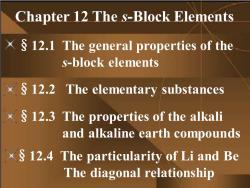
Chapter 12 The s-Block Elements 12.1 The general properties of the s-block elements ק12.2 The elementary substances x 12.3 The properties of the alkali and alkaline earth compounds X 12.4 The particularity of Li and Be The diagonal relationship
§12.1 The general properties of the s-block elements §12.4 The particularity of Li and Be The diagonal relationship §12.3 The properties of the alkali and alkaline earth compounds §12.2 The elementary substances Chapter 12 The s-Block Elements

12.1 The general properties of the s-block elements The alkali metals (IA )nsl Li,Na,K,Rb,Cs,Fr The alkaline metals (IIA )ns2 Be,Mg,Ca,Sr,Ba,Ra They are all active metals
§12.1 The general properties of the s-block elements The alkali metals (IA ):ns1 Li, Na, K, Rb, Cs, Fr The alkaline metals (IIA ):ns2 Be, Mg, Ca, Sr, Ba, Ra They are all active metals

IA IIA electronegativity Li Be Decreasing ionization energy and Increasing metallicity and reductibility Increasing atomic Na Mg K Ca Rb Sr radius Cs Ba Decreasing atomic radius Decreasing metallicity and reductibility Increasing ionization energy and electronegativity
electronegativity Decreasing ionization energy and Increasing metallicity and reductibility Increasing atomic radius IA IIA Li Be Na Mg K Ca Rb Sr Cs Ba Decreasing atomic radius Decreasing metallicity and reductibility Increasing ionization energy and electronegativity

General properties of S block elemental substancs 1.React with H2 to produce ionic compounds M+H1, M+2H-12(except for Be,Mg); 2.React with O2 to form oxide(O2),peroxide(O22-), superoxide (O2); 3.React with water and non-metallic elements to form the corresponding compounds except for Be and Mg; 4.Dissolve into liquid NH3 to form blue reducing solution except for Be Note:they show different activities
1. React with H2 to produce ionic compounds M+1H-1 、 M+2H-1 2 (except for Be, Mg); 2. React with O2 to form oxide(O2- ), peroxide(O2 2- ), superoxide (O2 - ); 3. React with water and non-metallic elements to form the corresponding compounds except for Be and Mg; 4. Dissolve into liquid NH3 to form blue reducing solution except for Be General properties of S block elemental substancs Note: they show different activities

12.2 The elementary substances 12.2.1 The properties of the elementary substances 1.Physical properties ☆Metallic luster; ☆Low densities;. ☆Soft; ☆Low melting point; *Good conductor of heat and electricity Na Li K
§12.2.1 The properties of the elementary substances Na Li K 1.Physical properties §12.2 The elementary substances ☆Metallic luster; ☆Low densities; ☆Soft; ☆Low melting point; ☆Good conductor of heat and electricity
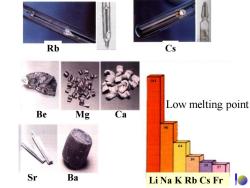
Rb 181 Low melting point Be Mg Ca 98 29 27 Sr Ba Li Na K Rb Cs Fr
Be Mg Ca Sr Ba Rb Cs Low melting point Li Na K Rb Cs Fr
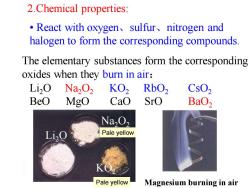
2.Chemical properties: ·React with oxygen、sulfur、nitrogen and halogen to form the corresponding compounds. The elementary substances form the corresponding oxides when they burn in air: Li,O Na202 KO2 RbO2 CsO2 BeO MgO CaO SrO BaO2 Na,O, Pale yellow Pale yellow Magnesium burning in air
The elementary substances form the corresponding oxides when they burn in air: Li2O Na2O2 KO2 RbO2 CsO2 BeO MgO CaO SrO BaO2 • React with oxygen、sulfur、nitrogen and halogen to form the corresponding compounds. 2.Chemical properties: Magnesium burning in air Li2O Na2O2 KO2 Pale yellow Pale yellow

.React with water 2M+2H,O->2MOH+H2(g) Li Na K Bromothymol blue indicator 溴百里酚兰指示剂 Ca
•React with water Li Na K Ca 2M + 2H2O → 2MOH + H2 (g) Bromothymol blue indicator 溴百里酚兰 指示剂
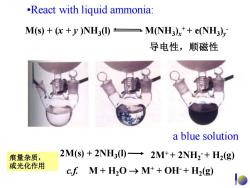
React with liquid ammonia: M(s)+x+y)NH3(I)M(NH3)++e(NH3) 导电性,顺磁性 a blue solution 痕量杂质, 2M(S+2NH3(0)→2M++2NH2+H2(g) 或光化作用 cfM+H20→Mt+OH+H2(g)
•React with liquid ammonia: a blue solution 2M(s) + 2NH3 (l) 2M+ + 2NH2 -+ H2 (g) c.f. M + H2O → M+ + OH- + H2 (g) M(s) + (x + y )NH3 (l) M(NH3 )x + + e(NH3 )y - 导电性,顺磁性 痕量杂质, 或光化作用
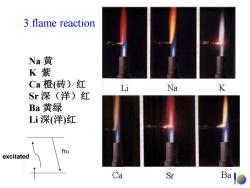
3.flame reaction Na黄 K紫 Ca橙(砖)红 Li Na K Sr深(洋)红 Ba黄绿 L深(洋)红 hu excitated Ca Sr Ba
3.flame reaction Na 黄 K 紫 Ca 橙(砖)红 Sr 深(洋)红 Ba 黄绿 Li 深(洋)红 excitated h
按次数下载不扣除下载券;
注册用户24小时内重复下载只扣除一次;
顺序:VIP每日次数-->可用次数-->下载券;
- 北京化工大学:《无机化学》课程电子教案(PPT课件,2013)Chapter 11 Coordination Compound Structures.ppt
- 北京化工大学:《无机化学》课程电子教案(PPT课件,2013)Chapter 10 Solid Structure.pptx
- 北京化工大学:《无机化学》课程电子教案(教学课件,2012)Chapter 4 Chemical equilibria, entropy and Gibbs function.pdf
- 北京化工大学:《无机化学》课程电子教案(PPT课件,2013)Chapter 4 Chemical equilibria, entropy and Gibbs function.ppt
- 北京化工大学:《无机化学》课程电子教案(PPT课件,2013)Chapter 6 Precipitation-Solubility Equilibria.ppt
- 北京化工大学:《无机化学》课程电子教案(PPT课件,2013)Chapter 5 Acid-Base Equilibrium.ppt
- 北京化工大学:《无机化学》课程电子教案(PPT课件,2013)Chapter 2 Thermochemistry.ppt
- 北京化工大学:《无机化学》课程电子教案(PPT课件,2013)Chapter 1 Preface.ppt
- 北京化工大学:《无机化学》课程电子教案(教学课件,2012)Chapter 8 Atomic Structure.pdf
- 北京化工大学:《无机化学》课程电子教案(教学课件,2012)Chapter 7 Redox Reactions and the Base of Electrochemistry.pdf
- 北京化工大学:《无机化学》课程电子教案(教学课件,2012)Chapter 6 Precipitation-Solubility Equilibria.pdf
- 北京化工大学:《无机化学》课程电子教案(教学课件,2012)Chapter 5 Acid-Base Equilibrium.pdf
- 北京化工大学:《无机化学》课程电子教案(教学课件,2012)Chapter 2 Thermochemistry.pdf
- 北京化工大学:《无机化学》课程电子教案(教学课件,2011)Chapter 16 The d-block elements(Ⅰ).pdf
- 北京化工大学:《无机化学》课程电子教案(教学课件,2011)Chapter 15 p-block elements(Ⅲ).pdf
- 北京化工大学:《无机化学》课程电子教案(教学课件,2011)Chapter 14 p-block elements(Ⅱ).pdf
- 北京化工大学:《无机化学》课程电子教案(教学课件,2011)Chapter 17 The d-block elements(Ⅱ).pdf
- 北京化工大学:《无机化学》课程电子教案(教学课件,2011)Chapter 09 Molecular Structure.pdf
- 北京化工大学:《无机化学》课程电子教案(教学课件,2011)Chapter 07 Redox Reactions and Base of Electrochemistry.pdf
- 北京化工大学:《无机化学》课程电子教案(教学课件,2011)Chapter 13 The p-block elements(Ⅰ).pdf
- 北京化工大学:《无机化学》课程电子教案(PPT课件,2013)Chapter 13 The p-block elements(Ⅰ).ppt
- 北京化工大学:《无机化学》课程电子教案(PPT课件,2013)Chapter 14 Chapter 14 The p-block elements(Ⅱ).ppt
- 北京化工大学:《无机化学》课程电子教案(PPT课件,2013)Chapter 15 The p-block elements(Ⅲ).ppt
- 北京化工大学:《无机化学》课程电子教案(PPT课件,2013)Chapter 16 The d-block elements(Ⅰ).ppt
- 北京化工大学:《无机化学》课程电子教案(PPT课件,2013)Chapter 7 Redox Reactions and the Base of Electrochemistry.ppt
- 北京化工大学:《无机化学》课程电子教案(PPT课件,2013)Chapter 8 Atomic Structure.ppt
- 北京化工大学:《无机化学》课程电子教案(PPT课件,2013)Chapter 9 Molecular Structure.ppt
- 北京化工大学:《无机化学》课程电子教案(课件讲稿,2015)Chapter 1 Preface(负责人:周云山).pdf
- 北京化工大学:《无机化学》课程电子教案(课件讲稿,2015)Chapter 2 Basic of thermodynamics.pdf
- 北京化工大学:《无机化学》课程电子教案(课件讲稿,2015)Chapter 4 Chemical equilibria.pdf
- 北京化工大学:《无机化学》课程电子教案(课件讲稿,2015)Chapter 5 Atomic Structure.pdf
- 北京化工大学:《无机化学》课程电子教案(课件讲稿,2015)Chapter 6 Molecular Structure and covalent bond theory.pdf
- 北京化工大学:《无机化学》课程电子教案(课件讲稿,2015)Chapter 7 Crystal Structure.pdf
- 北京化工大学:《无机化学》课程电子教案(课件讲稿,2015)Chapter 8 Acid-Base Equilibrium.pdf
- 北京化工大学:《无机化学》课程电子教案(课件讲稿,2015)Chapter 9 Precipitation-Solubility Equilibria.pdf
- 北京化工大学:《无机化学》课程电子教案(课件讲稿,2015)Chapter 10 Reduction - oxidization Reactions.pdf
- 北京化工大学:《无机化学》课程电子教案(课件讲稿,2015)Chapter 11 Basic of Coordination Chemistry.pdf
- 北京化工大学:《无机化学》课程电子教案(课件讲稿,2015)Chapter 12 The alkali and alkaline earth metal.pdf
- 北京化工大学:《无机化学》课程电子教案(课件讲稿,2015)Chapter 13 The elements of boron family.pdf
- 北京化工大学:《无机化学》课程电子教案(课件讲稿,2015)Chapter 14 The elements of carbon family.pdf
